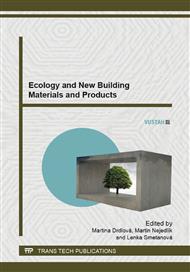p.326
p.330
p.334
p.338
p.342
p.346
p.352
p.356
p.360
Stabilization of Indoor Humidity by Rammed Earth
Abstract:
Clay and earthen materials are highly hygroscopic and thus able to effectively adsorb and release moisture from their surroundings. This paper analyses the ability of rammed earth to stabilize internal course of relative humidity. A numerical hygrothermal model is introduced and validated using a set of measured data according to IEA Annex 41. The model is then used to determine the stabilization effect of rammed earth in a residential room with defined moisture sources and ventilation rate. The simulation is performed for gypsum boards, concrete and red brick as well and a clear comparison is made. The results show that the rammed earth can most effectively moderate the indoor air humidity variations; followed by concrete, gypsum boards, and red brick.
Info:
Periodical:
Pages:
342-345
Citation:
Online since:
August 2014
Authors:
Keywords:
Price:
Сopyright:
© 2014 Trans Tech Publications Ltd. All Rights Reserved
Share:
Citation:


